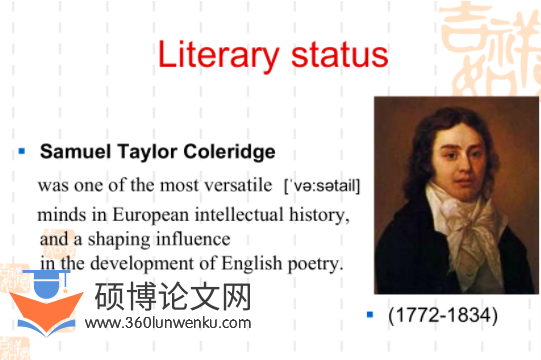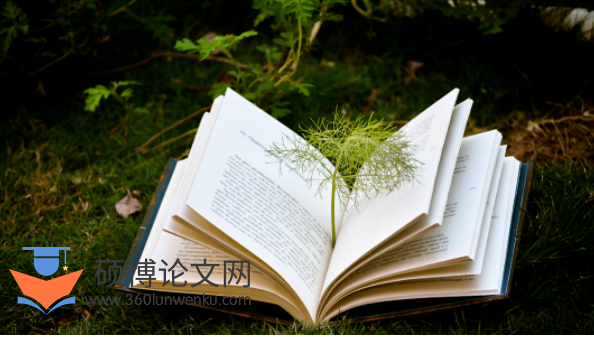本文是一篇英语论文,笔者本文通过对柯勒律治诗歌的个案研究,探讨每一种声音是如何发展的,从而打开诗人对各个方面的思考,从而为柯勒律吉的诗歌提供了新的阐释方式,并为研究他对人、自然和上帝关系的沉思以及他的诗歌创造力提供了一个新的视角。
Chapter One The Literary Shift from Sight to Sound
1.1 The Definition of Sound

英语论文怎么写
The relation of sound to poetry has always been ambiguous and shifting, because sound is itself a slippery word, especially in the context of poetry. On the one hand, sound defined by The Oxford English Dictionary as “the audible articulation corresponding to a letter or word”, has been understood as independent from linguistic meaning. It is translated as a “mere audible effect without significance or real importance”, as the OED puts it. Or, more famously, in Shakespeare’s lines: “a tale / told by an idiot, full of sound and fury, / signifying nothing” (Shakespeare, 1807: 206). Sound is thus interpreted as a nonsense soliloquy which has merely audible effect without any coherent meaning.
Then how is sound in the acoustic sense related to poetry? To answer this question, it’s necessary to trace its origin. Poetry in the ancient Greek form “poiesis” refers to the making or creation that is orally composed and orally recited. In this sense, poetry is essentially an art of sound which involves orality. Every poem has a texture of sound, which is at least as important as its content. As James William Johnson notes, “the irreducible denominator of all lyric poetry must comprise those elements which it shares with the musical forms that produced it. Although lyric poetry is not music, it retains structural or substantive evidence of its melodic origins, and this factor serves as the categorical principle of poetic lyricism” (Johnson, 1993: 714-715). This definition reasonably stresses the structuring of sound as “irreducible denominator” of lyric, and recognizes the central importance of sound to poetry.
..............................
1.2 The Shift to Sound in the Romantic Era
The relationship between poetry and music has been one of the most debated issues in the history of criticism. It is important to note, however, that the marriage between poetry and image is a longer one. In fact, it dates back to the days of ancient Greece when Simonides of Ceos (556-468 BC) observed that, “painting is mute poetry, and poetry a speaking picture” (qtd. in Lee, 1940: 197). Centuries later, this close relationship between painting and poetry was further strengthened by the ancient Roman literary critic Quintus Horatius Flaccus (65-8 BC). In his epistle “The Art of Poetry” (Ars Poetica in Latin), Horace proposed the famous doctrine ut pictura poesis, which was translated “a poem is like a picture” (Horatius, 1942: 480-481). The application of this formula began in the Renaissance, when the artists and art critics tried to “raise painting to the status of a liberal art” (O’Donoghue, 2005: 72). It was so frequently quoted and fundamentally acknowledged that critics in the Renaissance deemed the vivid effect brought by the visual image as the standard of ideal poetry. Furthermore, the critics of the sixteenth century continued the analogies between poetry and painting, and made “their references to certain poets as painters at once quite natural and a handsome compliment to the word-painting of the poets concerned” (Lee, 1940: 198). In any event, the validity of ut pictura poesis was recognized and the association of painting with poetry was deeply rooted. The relationship between the “sister arts” was thus sustained for centuries (Hagstrum, 1958: 19).
However, the sister arts increasingly fell into competition in the eighteenth century. Gotthold Ephraim Lessing (1729-1781) was in the pioneering position of objecting to ut pictura poesis. In his critical work Laocoon: An Essay on the Limits of Painting and Poetry (1766), Lessing tried to separate the two arts as two radically different and independent modes of representation—poetry as the temporal art and painting as the spatial art. By listing the differences and limits of the two arts, Lessing objected to the doctrine ut pictura poesis which had long been held as fundamental, and evoked further confusion of the two arts. What followed was a distinction between words and images with Burke’s categories of the beautiful and the sublime. According to Burke, the “union of affecting words” was powerful and sublime, and the beautiful images would weaken that power: “Indeed so little does poetry depend for its effect on the power of raising sensible images, that I am convinced it would lose a very considerable part of its energy, if this were the necessary result of all description” (Burke, 1999: 155). In this sense, poetry should be the ultimate expression of language free from the tyranny of images.
..............................
Chapter Two Sounds in the Natural World
2.1 Melodious Nightingale: The Articulation of Life
Throughout literary history, the song of the nightingale has been regarded as an expression of Philomela’s unfortunate encounter: her story of being raped, taken prisoner, having her tongue cut out, and her lament. Therefore, the nightingale’s song is necessarily lonesome and sad. Publius Ovidus Naso (43BCE-18CE), who offered a detailed version of the myth, personified the nightingale as a beautiful, sad, and seductive female figure. Milton, then, further related the nightingale to melancholy and darkness in “IL Penseroso” (1631):
Less Philomel will design a Song, In her sweetest, saddest plight, Smoothing the rugged brow of night, While Cynthia checks her Dragon yoke Gently o’er th’ accustom’d Oak; Sweet Bird that shunn’st the noise of folly Most musical, most melancholy! (IL Penseroso, L56-62)
n important contrast to the lark in “L’Allegro” who “startles the dull night” and brings delight in the early morning (L’Allegro, L42), the nightingale in “IL Penseroso” utters melancholy sounds. Milton’s melancholy birdsong is associated with Ovid’s tale, and is in turn inherited by the Romantics: Keats’s nightingale is a subtle Philomel that sings in the dark and makes Keats contemplate upon death. Shelley believes that sorrow is the source of the nightingale’s “sweet sounds” in his A Defense of Poetry. Akin to this is Coleridge’s endorsement of the Miltonic nightingale in his “To the Nightingale” (1795). He follows the cliche about the melancholic characteristic of the nightingale’s song and describes its song as “sad pity-pleading strains” (To the Nightingale, L11). And above all, he addresses it using Milton’s description of “most musical, most melancholy”. However, an exception to the melancholy tone occurs in his first namely conversation poem, “The Nightingale: A Conversation Poem. April, 1798”, in which the poet manifests a joyful tone of the nightingale.
...............................
2.2 Solitary Silence: The Space for Reflection
Silence is conventionally deemed as the opposite of sound which carries negative quality. However, careful readers will find that, the seemingly worthless “silence”, is favored by many Romantics. Wordsworth, Coleridge, Shelley, Keats and Byron have more or less adopted this conception in their works. Silence for them, means not loneliness, but a core element of Romantic experience of interior solitude:
We might think that the desire for solitude is simply the desire for the absence of sound, but that is not plausible. For one thing, we are never in fact surrounded by a total absence of sound; something is always making sounds. What one can find in nature is often “silence” of a special sort. Negatively, this silence is the absence of human-made sounds, but positively this silence comprises a background of low-level sounds that provide a sonic carpet on which other sounds of nature appear to great effect (Fisher, 1998: 170).
Actually, the true silence does not exist, so the “silence” here should be defined in relative terms. The Romantic aspect of silence or tranquility is actually a kind of personal experience, in which there is no intrusion of his thought-world. Coleridge picks out the word “silence” from this background, and recognizes the philosophical and poetic resources latent in it. He loves solitude, evening and silence, not for itself alone, but as a medium for social, spiritual, and imaginative musings.
................................
Chapter Three Sounds in the Supernatural Land ..................................... 31
3.1 Terrifying Acoustics on the Sea ...................................... 31
3.2 The Recurring Bell in the Castle .................................... 37
Chapter Four Mental Voices of a Romantic Mind .................................. 43
4.1 The Music of the Eolian Harp: Utterance of a Divided Soul ............................. 43
4.2 The Wind Storm: Poetic Expression of Dejection .............................. 50
Conclusion .......................... 56
Chapter Four Mental Voices of a Romantic Mind
4.1 The Music of the Eolian Harp: Utterance of a Divided Soul

英语论文参考
“The Eolian Harp” has attracted a good deal of scholarly attention. Much of this interest stems from the fact that the poem is a complex and perplexing text which is greatly revised over a period of twenty-three years. The image of the eolian harp shifts its meaning from its original context in the early volume to the later ones, so does its music. That is to say, in order to get the metaphorical references of music of the wind’s harp, readers must have a clear understanding of what Coleridge emphasizes in each version.
The first draft is merely seventeen lines in length, which entitles “Effusion 35. Clevedon, August 20th, 1795”. It was composed when Coleridge was engaged to marry Sara Fricker. The two visited Clevedon to rent the cottage so as to spend their first months of marriage. It can be seen as “a honeymoon poem” that depicts a peaceful domestic scene: a man is seated by the cottage at evening, his bride leaning against his arm, receptive to the light, scents and sounds from without (Wendling, 1968: 29). Cot, sea and sky, all bring the couple sensory delight and genuine inner peace. In the partly opened window they place that favorite musical instrument, an Aeolian harp, whose strings, in response to a current of air or wind, vibrate into various musical sounds. With such tender in arms, Coleridge makes a right-for-scene analogue in which the harp is assimilated to a girl who is flirting with her beloved: “Like some coy maid half willing to be woo’d / Utters such sweet upbraidings” (“The Eolian Harp” of 1795, L17-18). Immersed in the gentle will of his bride-to-be, Coleridge here compares Sara to the harp, himself to the breeze, and her “sweet upbraiding” to the harp’s music. It is the wind playing on the harp that gives the voice of love they feel for each other. Dramatized by this occasion of the poem, the eolian harp is feminine and passive, the wind male and active. And their dalliance in the air thus romances out a music that is playful as well as erotic.
.....................................
Conclusion
While the element of sound has long permeated the verses of English Romantic poetry, Coleridge renews and revitalizes its significance. As a faithful listener of nature, Coleridge spares no ears to perceive sounds of the natural events. By building the onomatopoeic world of animate clatter, Coleridge manages to perform poetic impressions of birdsong of the nightingale, and to present the essence of “life” and “joy”. And his indulgence in the solitary silence, inspires readers to give attention to another special sound in nature. By appreciating the value of sound and silence in his nature poems, readers can find Coleridge’s concern with the relationship between man and nature, as well as the social and communal function of silence.
However, sound is not as delightful as it has always been. In Coleridge’s supernatural poems the sounds that readers hear are haunting, and even daemonic. They are of not merely aesthetic meaning, but artistic importance: With the aid of the horror-provoking sounds and sonic effects Coleridge deals logically with not only the relationship of those characters in the story as in “Christabel”, but also the relationship between characters and the audience (by attaining acceptability for all those unnatural happenings) in “The Rime of the Ancient Mariner”. In this way, sound exists not for itself, but to serve the effective telling of a dramatic story. It becomes a forceful means by which Coleridge demonstrates the unique artistic qualities of his poetry.
reference(omitted)
